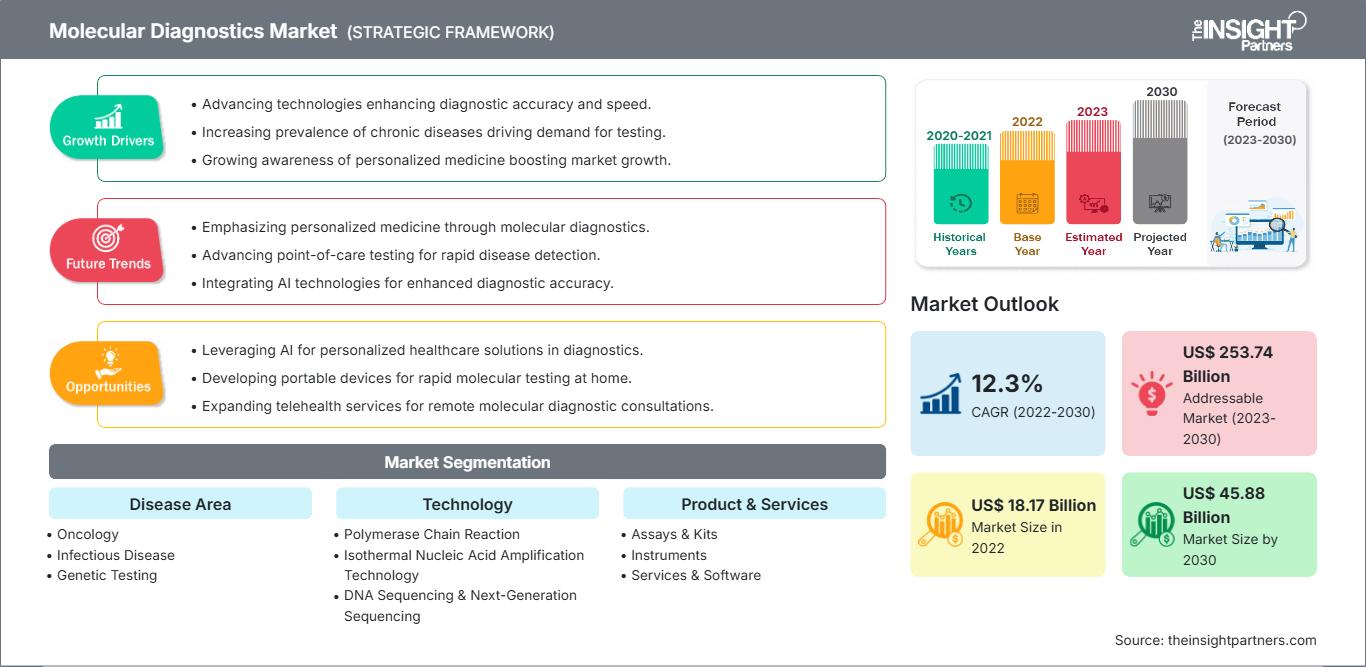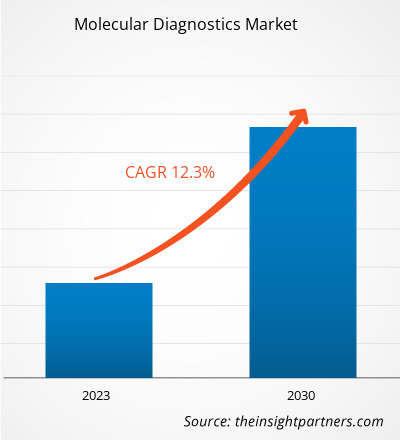[研究报告] 2022年分子诊断市场价值为181.7387亿美元,预计到2030年将达到458.7565亿美元。预计预测期内的复合年增长率为12.3%。
市场洞察和分析师观点:
分子诊断程序可用于检测多种疾病,例如肿瘤疾病、传染病、心脏病和免疫系统疾病;它们还可用于利用DNA和RNA等遗传物质进行基因检测,以诊断不同的疾病。新产品的开发、对即时检测的需求增加以及相关疾病的患病率激增。然而,分子检测的局限性阻碍了分子诊断市场的增长。
增长动力和机遇:
新产品的开发和即时检验需求的增长
领先的医疗器械制造商和其他在相关市场运营的企业正在积极参与产品创新和开发过程。以下列举了分子诊断市场中的一些重要发展。
月度 &年份 |
描述 |
|
2021 年 7 月 |
雅培 (Abbott) 在印度推出了其 Panbio COVID-19 快速抗原检测。 |
|
2021 年 7 月 |
西门子医疗 (Siemens Healthineers) 在其位于印度巴罗达 (Vadodara) 的工厂开始生产 IMDX SARS-CoV2 和其他分子诊断试剂盒。 |
|
2021 年 7 月 |
Bio-Rad Laboratories, Inc. 推出了用于体外诊断的 Reliance SARS-CoV-2/FluA/FluB RT-PCR 试剂盒。该试剂盒包含标准和阴性分子对照以及检测试剂。经验证,它可以在 Bio-Rad 的 CFX96 Dx 实时 PCR 系统上运行,也可以在其他制造商的其他实时 PCR 系统上运行。 |
|
2021 年 9 月 |
Chembio Diagnostics, Inc. 向美国食品药品监督管理局 (FDA) 提交了其 DPP 呼吸道抗原面板测试系统的紧急使用授权 (EUA) 申请。它旨在促进从单个患者的鼻拭子样本中同时、离散和鉴别检测甲型流感、乙型流感和 SARS-CoV-2 抗原等。 |
|
2021 年 9 月 |
安捷伦科技公司与 Visiopharm 签署了一项全球分销协议,该协议使安捷伦能够联合销售 Visiopharm 获得 CE-IVD 标志的人工智能 (AI) 驱动的精准病理学软件产品组合,以及安捷伦自己的自动化病理染色解决方案产品组合。 |
|
2021 年 10 月 |
西门子医疗推出了 CLINITEST 快速 COVID-19 检测,这是一种可在 15 分钟内产生结果的快速抗原检测。 |
|
12 月2020 |
赛默飞世尔科技收购了Phitonex公司,后者位于北卡罗来纳州达勒姆,率先推出了用于高分辨率生物学应用的光谱染料平台,旨在加速细胞疗法、免疫肿瘤学和免疫学领域的研发。Phitonex的产品组合将使赛默飞世尔科技能够提供更强大的流式细胞术和成像多路复用功能,以满足客户在蛋白质和细胞分析研究中不断变化的需求。 |
来源:The Partners Analysis
即时检验(POCT)是医学的一个分支,其分析范围和临床应用正在快速发展。即时检验解决方案提供商提供用于各种评估的产品,从血糖测量到粘弹性凝固试验。这些测试省去了运输和制备临床样本的时间,使专业人员能够在更短的时间内做出关于进一步检测或治疗的临床决策。这种新兴的医疗保健解决方案正被患者和医疗服务提供商积极采用。即时检测广泛应用于治疗、诊断和患者监护等领域。此外,即时检测产品和服务能够帮助医疗保健提供者满足患者的居家医疗需求。这些产品和服务在新冠疫情期间尤其有效,患者无需前往诊断或治疗机构即可在家中接受检测,从而降低了感染风险。因此,即时检测需求的不断增长将有利于分子诊断市场。
自定义此报告以满足您的要求
您将免费获得任何报告的定制,包括本报告的部分内容,或国家级分析、Excel 数据包,以及为初创企业和大学提供超值优惠和折扣
分子诊断市场: 战略洞察

-
获取本报告的主要市场趋势。这个免费样本将包括数据分析,从市场趋势到估计和预测。
分子诊断技术的进步
分子诊断技术和平台正应用于解剖学和临床病理学的各个领域。分子诊断测试可以检测与疾病相关的DNA或RNA序列,包括单核苷酸多态性、缺失、重排和插入。COVID-19出现后,分子诊断得到了进一步的改进。传统的检测方法包括CT扫描、血液学检测和RT-PCR。随着2020年COVID-19病例的迅速增长,对快速、精准的检测平台的需求激增,以克服传统检测的不足。计算机断层扫描(CT)是一种成本高昂的检查程序,并非所有医院都配备,它无法检测无症状患者的病毒感染和其他疾病。广泛使用的RT-PCR也耗时且昂贵,并且无法在感染早期检测到低病毒载量。因此,研究人员开发了检测 SARS-CoV-2 的新方法,这些方法速度更快、成本更低。逆转录环介导等温扩增 (RT-LAMP)、基于微阵列的检测、基于适体的诊断、SHERLOCK、SHERLOCKv2、FET 生物传感器、基于细胞的电位诊断和分子印迹技术是为 COVID-19 诊断开发的新型分子诊断技术的一些示例。过去几年,FDA 的报告表明,分子检测、抗原依赖性检测和血清学检测方面的进展已获得批准。不同国家的科学界为控制 COVID-19 大流行和降低死亡率而开展的合作努力,使整个分子工具和诊断领域受益,这可能为未来的分子诊断市场创造巨大的机遇。
报告细分和范围:
“全球分子诊断市场”分子诊断市场按疾病领域、技术、产品和服务、最终用户和地域进行细分。按疾病领域,分子诊断市场细分为肿瘤学、传染病、基因检测、心脏病、免疫系统疾病等。按技术,分子诊断市场细分为聚合酶链式反应、等温核酸扩增技术、DNA测序和下一代测序、DNA微阵列、原位杂交等。按产品和服务,分子诊断市场细分为检测和试剂盒、仪器以及服务和软件。按最终用户,分子诊断市场细分为医院和诊所、诊断实验室、研究和学术机构等。从地理上看,分子诊断市场分为北美(美国、加拿大和墨西哥)、欧洲(德国、法国、意大利、英国、俄罗斯和欧洲其他地区)、亚太地区(澳大利亚、中国、日本、印度、韩国和亚太其他地区)、中东和非洲(南非、沙特阿拉伯、阿联酋和中东和非洲其他地区)以及南美洲和中美洲(巴西、阿根廷和南美洲和中美洲其他地区)。
分段分析:
基于技术,分子诊断市场细分为聚合酶链式反应、等温核酸扩增技术、DNA测序和下一代测序、DNA微阵列、原位杂交等。PCR进一步细分为RT-PCR、qPCR、多重PCR等。 PCR 领域在 2022 年占据了最大的市场份额,预计在预测期内,该领域的复合年增长率将达到 12.7%。PCR 主要用于通过复制核酸链来制造或扩增 DNA。在扩增过程中,使用热循环仪使 DNA 链变性和退火,并使用酶、核苷酸和缓冲液等试剂来构建新的 DNA。该技术广泛应用于基因功能分析、遗传诊断、DNA 克隆、亲子鉴定、传染病检测和法医学等各种应用。聚合酶链式反应 (PCR) 分为传统 PCR、实时 PCR 和数字 PCR。然而,疫情期间技术的持续进步和需求的激增将继续刺激印度以及其他亚太国家对 PCR 检测的需求。结核病、肝炎、流感和严重感染等疾病的持续流行将促进即时检测 (PoC) 分子诊断行业的发展趋势。目前,新型冠状病毒肺炎 (COVID-19) 疫情的爆发将为市场创造丰厚的增长机会,因为这种方法对于检测无疾病症状的个体中的病毒至关重要。PCR 的高灵敏度、相对简单性和成本效益使 PCR 有别于其他核酸扩增技术,巩固了其作为分子实验室主流技术的地位。由于 PCR 技术的持续研发,PCR 已成为各种临床和诊断应用或检查不可或缺的工具。因此,它为各种传染病的快速即时诊断提供了许多机会。例如,罗氏公司 (F. Hoffmann-La Roche Ltd) 一直致力于数字 PCR (dPCR) 技术的进步。dPCR 已将其应用扩展到临床领域,并已成为一种重要的临床工具。dPCR 可提供超灵敏和绝对的核酸定量,无需参考标准。因此,它为实验室之间的结果标准化和比较提供了更广泛的方面。在疫情爆发期间,先行的初创公司之一 Mylab PathoDetect COVID-19 定性 PCR 试剂盒是去年印度首批获得中央药品标准控制组织 (CDSCO) 商业批准的试剂盒之一。获得批准后,Mylab 与生物技术巨头印度血清研究所和当地公司 AP Globale 合作。PCR 进一步细分为 RT-PCR、qPCR、多重 PCR 等。
根据疾病领域,分子诊断市场细分为肿瘤学、传染病、基因检测、心脏病、免疫系统疾病等。传染病领域在 2022 年占据了最大的市场份额。然而,预计肿瘤学领域在预测期内的复合年增长率最高,为 12.6%。肿瘤分子诊断是基于传递肿瘤信息的DNA、RNA和蛋白质,揭示遗传物质、蛋白质和相关分子,并评估代谢功能、药物代谢和疾病诱导的检测。世界卫生组织 (WHO) 表示,2020年癌症导致约1000万人死亡。此外,根据美国癌症协会2021年的统计数据,到2040年,全球癌症负担预计将增至2750万新增病例和1630万癌症死亡病例。如此高的数字表明,癌症发病率的上升正在加剧对早期诊断和预防性治疗的需求。诊断癌症的方法有很多,包括PCR、INAAT和NGS等。其中,PCR(聚合酶链式反应)的出现极大地推动了临床DNA检测的发展。基于PCR的方法只需要简单的仪器和基础设施,仅需少量生物材料,并且与临床常规操作高度兼容。
尽管PCR成本高昂,但最准确的实时PCR方法(准确率超过99%)是包括韩国在内的许多发达国家广泛使用的方法,而发展中国家则大量使用比实时PCR更经济实惠的传统PCR(准确率超过90%)。由于其他方法价格昂贵,欠发达国家通常使用快速PCR(准确率60-70%)。在肿瘤分子诊断领域,NGS是另一项增长速度最快的技术。许多公司正在努力实现这项技术的经济效益。例如,2021年4月,Illumina公司宣布与Kartos Therapeutics合作,共同开发基于NGS的TP53伴随诊断,这有助于降低与存储和管理基因组数据相关的成本。
基于产品和分子诊断服务市场细分为检测与试剂盒、仪器以及服务和软件。检测与试剂盒细分市场在2022年占据了最大的市场份额,预计在预测期内将实现最高的复合年增长率。分子诊断检测是广泛使用的分析技术之一。各种类型的检测,例如快速分子检测、逆转录聚合酶链反应 (RT-PCR)、抗原等,用于识别和分析各种疾病,例如流感、COVID-19、结核病等。作为产品创新和商业战略的一部分,市场参与者提供针对不同检测试剂盒的诊断试剂盒。区域参与者积极参与与该细分市场相关的业务开发。例如,2021年9月,Mylab Discovery Solutions收购了Sanskritech的多数股权,Sanskritech是Swayam平台的开发商,该平台是一种可在即时检测点进行约70项检测的即时检测系统。此外,在 COVID19 大流行中,各种全球市场参与者通过其区域业务部门提供试剂盒。基于上述因素,预计该部门将在预测期内做出显着贡献。
根据最终用户,分子诊断市场细分为医院和诊所、诊断实验室、研究和学术机构等。2022 年,诊断实验室部门占据了最大的市场份额。此外,由于各地区各种医疗状况的检测和诊断增加,预计该部门的需求在 2022 年至 2030 年期间将以 12.7% 的最快复合年增长率增长。诊断实验室是分子诊断产品和服务的主要用途。它根据监管要求拥有完善的设施。实验室使用所有可能的分子诊断产品和服务。使用不同的仪器、试剂、方法和技术对从患者身上采集的样本进行分析和研究。这些实验室为医院、诊所、家庭护理等提供服务。慢性病和传染病的日益流行以及个体研究人员外包分子诊断活动是预测期内支持该领域增长的因素之一。
区域分析:
从地理上看,分子诊断市场分为北美、欧洲、亚太地区、中东和非洲以及南美和中美。预计在预测期内,北美区域市场的复合年增长率为 12.5%。该地区在 2022 年占据最大份额,预计在预测期内将继续保持类似的趋势。
技术先进产品的采用率不断提高、研发活动的增加、大型医疗保健企业的存在以及分子诊断的使用日益增多是推动该地区分子诊断市场增长的关键因素。 2022 年,美国占据北美分子诊断市场的最大份额。
美国占据分子诊断市场的最大份额。该国市场的增长主要得益于慢性肾病 (CKD) 患病率的上升、老年人口的增加以及主要参与者推出的产品数量的增加。老龄化是导致肾脏疾病的主要危险因素。根据美国人口参考局 2020 年发布的一项研究,2020 年美国 65 岁人口为 5500 万,预计到 2060 年将达到 9500 万。美国监管机构正在制定优惠政策,以开发用于诊断和治疗各种适应症的即时诊断 (POC) 产品。例如,2021年3月,美国食品药品监督管理局 (FDA) 批准了首个使用Binx Health IO CT/NG检测试剂盒进行衣原体和淋病即时检测的授权,该试剂盒适用于社区诊所、紧急护理机构和门诊医疗机构等即时检测场所。2022年5月,全球领先的医疗技术公司之一BD(碧迪)宣布在美国推出其全新的全自动高通量传染病分子诊断平台。新款BD COR MX仪器已获得FDA的510(k)许可,是BD COR平台的全新分析仪器选项。 BD CTGCTV2分子检测是新系统上首个可用的检测,单次检测即可检测三种最常见的非病毒性性传播感染 (STI)——沙眼衣原体 (CT)、淋病奈瑟菌 (GC) 和阴道毛滴虫 (TV)。
亚太地区市场的增长归因于老龄人口的增长、癌症病例的增加、技术的进步以及初创企业、生物技术和生物制药公司数量的增加,这些因素正在推动该地区分子诊断市场的发展。此外,该地区研究活动的增多以及致力于提高癌症治疗质量的协会或组织的出现,也促进了分子诊断市场的增长。
分子诊断市场区域洞察
The Insight Partners 的分析师已详尽阐述了预测期内影响分子诊断市场的区域趋势和因素。本节还讨论了北美、欧洲、亚太地区、中东和非洲以及南美和中美洲的分子诊断市场细分和地域分布。
分子诊断市场报告范围
| 报告属性 | 细节 |
|---|---|
| 市场规模 2022 | US$ 18.17 Billion |
| 市场规模 2030 | US$ 45.88 Billion |
| 全球复合年增长率 (2022 - 2030) | 12.3% |
| 历史数据 | 2020-2021 |
| 预测期 | 2023-2030 |
| 涵盖的领域 |
By 疾病领域
|
| 覆盖地区和国家 |
北美
|
| 市场领导者和主要公司简介 |
|
分子诊断市场参与者密度:了解其对业务动态的影响
分子诊断市场正在快速增长,这得益于终端用户需求的不断增长,而这些需求的驱动因素包括消费者偏好的演变、技术进步以及对产品优势的认知度不断提高。随着需求的增长,企业正在扩展产品线,不断创新以满足消费者需求,并抓住新兴趋势,从而进一步推动市场增长。

- 获取 分子诊断市场 主要参与者概述
行业发展与未来机遇:
全球分子诊断市场主要参与者采取的各种举措如下:
- 2023年4月,凯杰公司(QIAGEN)在日本推出了QIAstat-Dx,该设备配备呼吸道检测面板,可用于综合征检测。日本将成为100多个国家中最新一个可以使用QIAstat-Dx进行分子检测的国家,该检测可以通过单个患者样本诊断20多种呼吸系统疾病。
- 2023年4月,诺华马来西亚公司(Novartis Malaysia)扩展了针对携带PIK3CA基因的乳腺癌(aBC)患者的分子诊断计划。这将使 PIK3CA 检测更加便捷,从而实现早期诊断和干预对晚期乳腺癌 (aBC) 患者生活质量的显著改善。
- 2023 年 1 月,安捷伦将与 Quest Diagnostics 合作,扩大安捷伦 Resolution ctDx FIRST 液体活检检测的覆盖范围。Quest 与安捷伦之间的协议将使 ctDx FIRST 得到广泛应用,ctDx FIRST 是一项在华盛顿 Resolution Bioscience CLIA 实验室进行的单点上市前批准 (ssPMA) 检测。
- 2023 年 2 月,西门子医疗宣布与 Unilabs 建立多年合作伙伴关系。此次合作将改善西门子的患者护理以及各种仪器的安装。
COVID-19 的影响:
在 COVID-19 疫情爆发之前,分子诊断市场的需求一直在稳步增长。随着聚合酶链式反应 (PCR) 等技术进步,分子诊断的应用在疫情爆发前就已日益普及。
疫情期间,疫情蔓延加上经济复苏的不确定性,对该地区的制药行业造成了影响。预计这种经济影响将对研发投资产生负面影响。一些分子诊断领域的关键参与者在保护医护人员和其他患者安全的同时,也为癌症患者提供了最佳的术后护理。雅培已获得紧急使用授权 (EUA),用于可在几分钟内提供结果的即时检测。因此,公司产量的增加带来了利润,而 COVID-19 的爆发对市场增长产生了积极影响。
竞争格局和关键公司:
全球分子诊断市场的一些知名公司包括雅培实验室、安捷伦科技公司、赛默飞世尔科技公司、罗氏公司、Qiagen NV、bioMerieux SA、Illumnia Inc.、丹纳赫、西门子医疗股份公司、诺华股份公司和 TBG Diagnostics Limited。这些公司专注于新产品的推出和地域扩张,以满足全球不断增长的消费者需求,并增加其专业产品组合的范围。他们拥有广泛的全球影响力,这使他们能够服务于大量客户,从而增加他们的市场份额。该报告提供了分子诊断市场的趋势分析,强调了各种参数,例如技术进步、市场动态以及全球主要市场参与者的竞争格局分析。
- 历史分析(2 年)、基准年、预测(7 年)及复合年增长率
- PEST和SWOT分析
- 市场规模、价值/数量 - 全球、区域、国家
- 行业和竞争格局
- Excel 数据集
近期报告
客户评价
购买理由
- 明智的决策
- 了解市场动态
- 竞争分析
- 客户洞察
- 市场预测
- 风险规避
- 战略规划
- 投资论证
- 识别新兴市场
- 优化营销策略
- 提升运营效率
- 顺应监管趋势






















 获取免费样品 - 分子诊断市场
获取免费样品 - 分子诊断市场